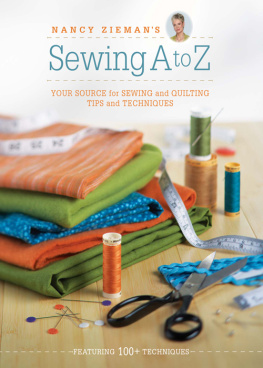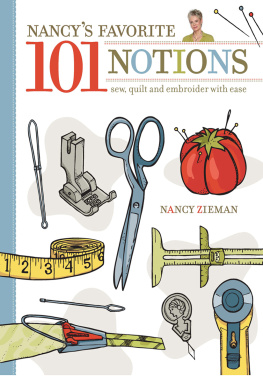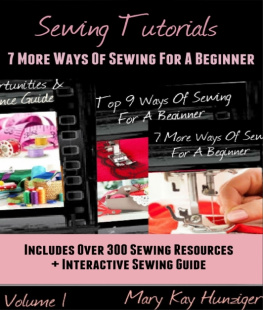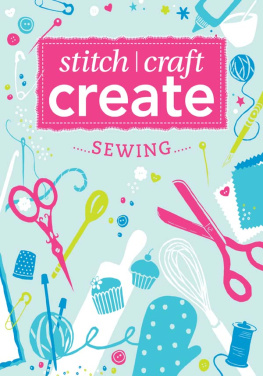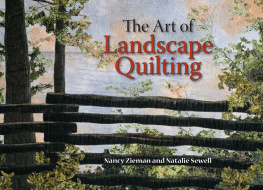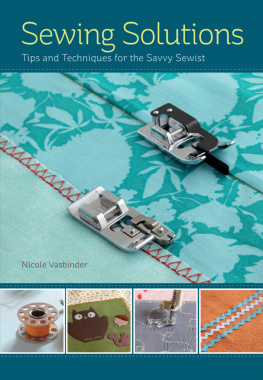Thank you for purchasing this Martha Pullen eBook.
Sign up for our newsletter and receive special offers, access to free content, and information on the latest new releases and must-have crafting resources! Plus, receive a coupon code to use on your first purchase from Store.MarthaPullen.com for signing up.
or visit us online to sign up at
http://marthapullen.com/ebook-promo
Nancy Ziemans Sewing A to Z. Copyright 2011 by Nancy Zieman. Manufactured in China. All rights reserved. No part of this book may be reproduced in any form or by any electronic or mechanical means including information storage and retrieval systems without permission in writing from the publisher, except by a reviewer who may quote brief passages in a review. Published by Krause Publications, a division of F+W Media, Inc., 4700 East Galbraith Road, Cincinnati, Ohio, 45236. (800) 289-0963. First Edition.
ISBN 13: 978-1-4402-1429-5
eISBN 13: 978-1-4402-2885-8
Edited by Kelly Biscopink
Designed by Julie Barnett
Production coordinated by Greg Nock
Photography by Al Parrish and Dale Hall
Illustrations by Laure Noe
Nancys Notions editorial staff: Diane Dhein and Pat Hahn
metric conversion chart
| TO CONVERT | TO | MULTIPLY BY |
| inches | centimeters | 2.54 |
| centimeters | inches | 0.4 |
| feet | centimeters | 30.5 |
| centimeters | feet | 0.03 |
| yards | meters | 0.9 |
| meters | yards | 1.1 |
Measurements have been given in imperial inches with metric conversions in bracketsuse one or the other as they are not interchangeable. The most accurate results will be obtained using inches.
About the Author

Nancy Zieman is executive producer and host of Public TVs Sewing With Nancy, where she has been teaching viewers the art of sewing, quilting and embroidering since 1982. She also founded Nancys Notions, a mail-order and online source for sewing and quilting products. As one of the sewing industrys most trusted voices, she has been honored and celebrated by organizations from the National 4H Club to the American Sewing Guild. So wherever you see a Note from Nancy, youll know youre getting expert advice!
ACKNOWLEDGMENTS
As the figurehead of a TV show and direct mail company, I tend to receive undeserved accolades for the successes of both entities. The proverb that includes the words it takes a village applies to life in general. My village is a tight-knit group of people who have worked with me over many decades.
My TV program should really be called Sewing With Nancy, Donna, Pat, Laure, Kate, Diane D., Diane S., Deanna, Lois, Gail and Erica. They comprise the dedicated village that shares a love of sewing and quilting. To them I extend my appreciation and give a heartfelt thank you for being loyal members of my team and great friends.
Contents

Techniques A to Z
A
B
C
D
E
F
G
H
I
J
K
L
M
N
O
P
Q
R
S
T
U
V
W
Y
Z

INTRODUCTION from NANCY
My first job after college was teaching sewing at a Minnesota Fabrics store in Chicago. Setting up twenty folding chairs in the middle of the store fifteen minutes prior to the demonstration constituted my first classroom. Since then, Ive taught in almost every venue possible, with the TV studio being my most recognized classroom.
During the past thirty-five years, Ive tweaked and personalized many of the common techniques. Many of these methods have been published in other books of mine, but theyve never been gathered together in an A-to-Z reference. My hope is that youll enjoy this quick reference and that these techniques will fine-tune your sewing and quilting skills.
Anchor Cloth
Stitch on a small scrap of folded fabric, or anchor cloth, to secure your stitches before sailing through the stitching of your project. Just a small stitching anchor solves a multitude of stitching problems! An anchor cloth prevents the fabric from being drawn down into the bed of the sewing machine and helps heavy fabric feed freely into the machine.
1 Fold a scrap of fabric 2 or 3 times to form an anchor cloth.
2 Begin stitching on the anchor cloth.
Its sometimes easiest to begin stitching in the middle of the cloth. Kiss the fabric next to the edge of the anchor cloth and continue stitching.
3 After the seam is completed, clip away the anchor cloth.

Appliqu: EDGE SATIN STITCH
A satin stitch is the most basic appliqu stitch and can be done on any machine that has an adjustable zigzag stitch. The stitches are formed so close together that they take on a satin appearance. Satin stitch appliqu eliminates the need to turn under the edges of the appliqu to keep it from fraying, plus it gives the project an enhanced appearance, especially when specialty threads are used for the stitching.
NOTE from NANCY
The completed appliqus will be mirror images of the tracing. Patterns that are already mirror images so they appear correctly on the completed project are the easiest to work with. If they are not already mirrored, trace the wrong side of the patterns over a light box.

1 Prepare the appliqus.
Trace the appliqu patterns onto the paper side of paper-backed fusible web.
Roughly cut out the designs, leaving ?(3mm-6mm) along the outer edges.

Press the paper-backed fusible web onto the wrong side of the fabric. Interface light-colored or sheer fabrics to prevent the fabric under the appliqu from showing through.

